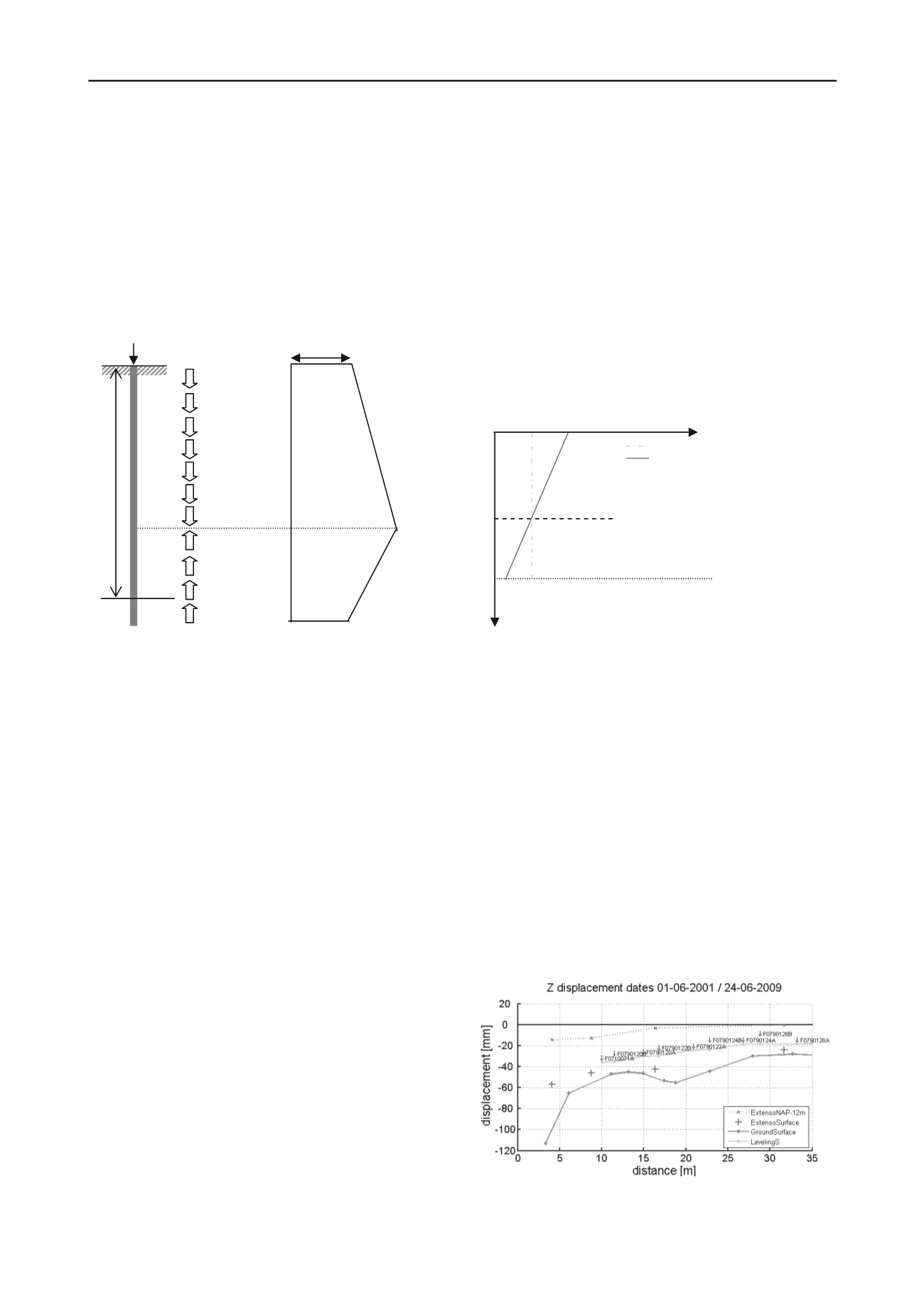
2037
Technical Committee 207 /
Comité technique 207
4 RESPONSE OF PILED BUILDINGS
For end bearing piles with sufficient factor of safety the neutral
level is found close to the location of the bearing layer. For the
most historic Amsterdam foundations, the reserve capacity is
smaller, and positive skin friction is also found in the soft or
settling layers. The maximum force in the pile is found at the
neutral level (the level at which the soil and pile settlements are
the same and the shear stresses acting on the pile change
direction). Usually in Amsterdam, it is considered that the
negative skin friction is already fully mobilized before the
excavation takes place.
Figure 5 Development of negative and positive skin friction along a pile
with low factor of safety
Buildings in the influence zone of the excavation may
experience several phenomena:
1. reduction of pile capacity due to lower stress levels (s
1
)
2. settlement of soil below the pile base (s
2
)
3. development of negative (or positive) skin friction due
to relative movements of the soil and the pile shaft (s
3
)
4. redistribution of pile load between the piles (s
4
)
5. horizontal deformations of the piles.
The settlement of the pile head is determined by the
combination of the first four effects described above:
s = s
1
+ s
2
+ s
3
+ s
4
(3)
Settlement s
1
for end bearing piles is significant if the pile tips
are very close to the excavation and stress relief takes place
around the pile tip. Settlement s
2
does not involve interaction
with the piles, whereas s
3
is a true interaction component. For
end bearing piles complying with current standards negative
skin friction, if already fully developed, will not cause
additional settlements, which means s
3
= 0. For all other piles s
3
depends on the amount of negative skin friction mobilized in the
initial state. If the shaft friction is already fully mobilized, the
neutral level will remain at about the same level and the pile
follows the settlement of the soil at this level. If the shaft
friction initially is not developed completely, the neutral level
will change if soil displacements take place. For piles close to
failure, the neutral level is found close to the surface and s
3
is
about equal to the surface settlement.
An important issue is to determine the initial neutral level.
This could be done theoretically based on CPT data or from
historic data of relative building settlements to surface
settlements. Based on the average pile capacity, the neutral level
for an old pile in Amsterdam is found to be between NAP -7
and NAP -12 m, depending on the load on the pile, see (Korff
2012). Assuming a linear relationship between the ground
settlement at surface and pile tip level, the pile-soil interaction
can be determined from the relative position of the neutral level
to the surface and the tip level, see Figure 6.
If the negative skin friction is not fully mobilized at the
initial state or if the tip resistance reduces, the skin friction will
further mobilize, which will raise the neutral level. Settlement s
3
might also include an elastic component of the shortening of the
pile if the total stress in the pile increases with increasing
negative skin friction. If the pile redistributes its load, s
4
needs
to be determined together with s
3
. This could occur if the piles
closest to the excavation settle more than the piles further away.
The building stiffness will prevent the building from following
the different pile movements and the pile load will redistribute
accordingly. If this happens, the external load on the pile
changes, leading to a new equilibrium. This effect should be
determined by a coupled analysis for a pile group, such as with
a boundary element method as described by (Xu and Poulos
2000).
F
building
Figure 6 Settlement profile and neutral level, assuming linear
relationship
5 BUILDING DISPLACEMENTS
The effects that cause the piles and hence the buildings to settle
have been evaluated by analysing substantial amounts of
monitoring data available from the Amsterdam cases. The
settlement of the building is compared to the greenfield soil
deformations at surface and pile tip level. It is not possible to
distinguish between the contributions of s
1
, s
3
and s
4
. Settlement
s
2
however can be directly evaluated against the results of the
extensometer measurements at pile tip level. Figure 7 shows the
building displacements (LevelingS) compared to the soil
displacements at surface (GroundSurface) and pile tip level
(ExtensoNAP-12m) for a series of buildings with old timber
piles. The settlement of these buildings is equal to the soil
settlement at approximately 0.3 to 0.5 times the pile length if a
linear soil settlement profile between the surface settlement and
the settlement at the first sand layer is assumed.
Figure 7 Ground and building displacements for CS13044 (at
Ceintuurbaan).
Neutral level
Soft layer
Pile def.
Soil def.
Foundation layer
S
z; surface
S
z; tip level
S
3
F
s;neg
Neutral level
Bearing
layer
Soft/
settling
layer
R
s;pos
shear
stress-
downward
shear
stress-
upward
R
b


